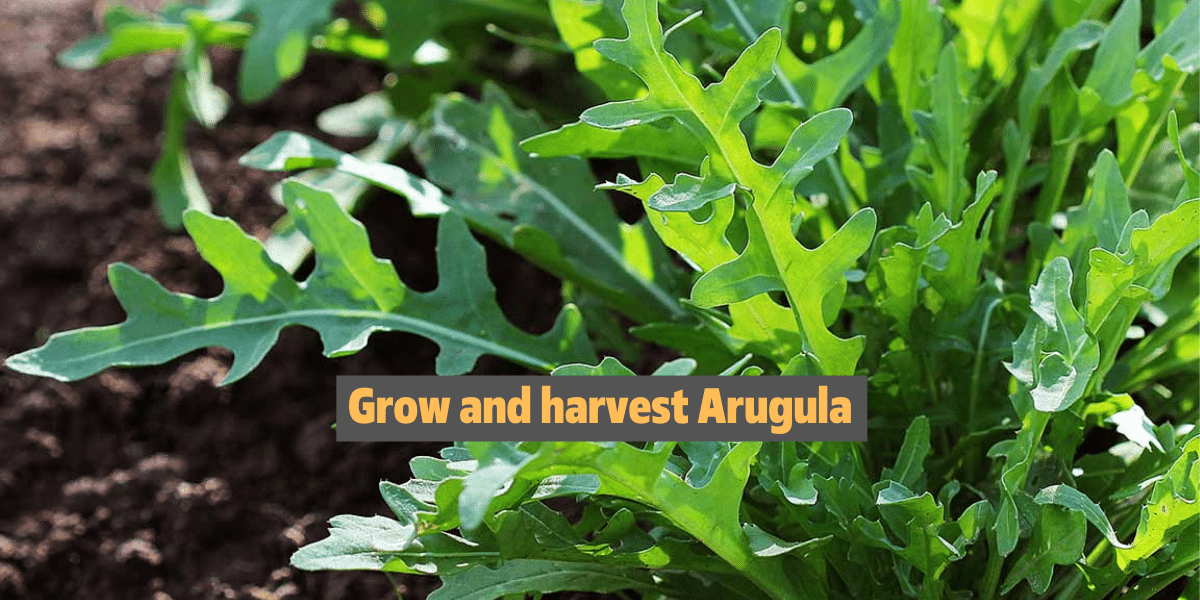How to Plant, Grow and harvest Arugula ?
How To Plant Grow And Harvest Arugula? Arugula is a leafy plant that is edible and used in various recipes. Before that, it is essential to know some of the basic things about the arugula plant and how to grow the arugula plant. There is a specific temperature and arugula seeds required for the production of the leafy plant. In this article, we explore some unknown facts of how to plant, grow and harvest arugula as well as everything related to it, such as the flavor of Arugula, Seeds of Arugula, Arugula sprouting, Rocket herbs, and so on.
Table of Content
An Overview About Arugula Plant
History of Arugula Plant
Arugula has a long history, encountering numerous pinnacles and valleys in ubiquity consistently and a few appearances in popular writing before showing up at its present predominance in everyday cooking.
Arugula has been around for a long time. It was even referenced in the Old Testament Book of Kings (II Kings 4:39, to be accurate).
In this way, we realize that Arugula’s set of experiences is a long one and collected as right on time as the sixth century B.C.Native to the Mediterranean district, arugula blooms and leaves have been mainstream fixing in Italy, Morocco, Portugal, and Turkey. Arugula was brought to America by British pioneers; however, it was not until the 1990’s that Arugula got known as a famous culinary fixing in the United States.
Different varieties of harvest Arugula Plant
Arugula is a quickly developing green ideal for the late-winter garden, yet it can likewise be planted in the pre-fall for a fall reap.
There is a variety of arugula plants. Let’s take a look at this :
Astro
For those of you who like Arugula yet less the zesty kick of specific assortments, the ‘Astro’ cultivar’s gentle yet peppery flavor may be an ideal match. Gather infant greens in only three weeks, or sit tight the full 38 days for significantly milder developed leaves. The edible white blossoms can likewise light up your servings of mixed greens.
Garden Tangy
This cultivar comes straightforwardly from Italy, making it an ideal topping for the entirety of your Italian-style dishes. With a zesty flavor and frilly leaf edges suggestive of kale, Garden Tangy’ adds a kick to pasta dishes, mixed greens, and that’s only the tip of the iceberg.
Italian Cress
With huge, lettuce-like leaves, ‘Italian Cress’ is an ideal expansion to servings of mixed greens and sandwiches. It’s likewise helpful for the individuals who battle with tolerance because each leaf gives bunches of palatable greenery contrasted with other, skinnier varieties. The vast leaves can likewise be sauteed like spinach or added to soups and stews. ‘Italian Cress’ develops in only 30 days. Let’s dive deeper into “how to plant, grow and harvest arugula“.
Plant harvest Arugula
Before planting arugula, you must have to know how to plant and grow arugula or harvest to know the whole process. It can be sown easily from seed and begin planting when the soil becomes pliable in spring. You need a spot in full sun or partial darken.
When to Plant harvest Arugula
Arugula develops quickly—set plants in the radiant nursery in late winter for spring harvest or pre-fall for fall gather. Plants favor the cooler long periods of spring or fall. Like any verdant green, Arugula requires rich soil to make its best development, and it will become stunningly better if you feed it with top-quality plant food, as well. Arugula seeds will grow in soil temperatures as low as 40°F (4°C), so sow them outside when the dirt can be worked in spring.
Where to grow and harvest Arugula
Every plant has different preferences for temperature, soil, and so much more. By far, we have discussed the arugula plant and now what is the best soil to grow the arugula plant and other details about it. Let’s take a look at this:
Best Soil
Arugula does best in supplement-rich, very much depleted soil. However, it will endure a wide assortment of conditions. It leans towards somewhat acidic soil with a pH somewhere in the range of 6 and 7.
Best Temperature
Arugula likes a cool climate—45 to 65 degrees Fahrenheit is ideal—yet it very well may be harmed or pushed by ice or snow. Keep the line covers helpful and secure your plants if an outrageous chilly climate is anticipated.
Humidity
If summers don’t get hot, keep planting until about a month before the expected first ice date.
Fertilizers
Arugula develops so quickly that a solitary utilization of high-nitrogen manure or rich fertilizer blended into the dirt at planting time is generally everything necessary. Extra taking care of is required just if the leaves are light green and undernourished, as in some cases occurs in extremely helpless soil. Like other verdant vegetables, nitrogen is a vital supplement for Arugula.
Water
The most excellent upkeep task is keeping your Arugula very much watered. Ordinary water will hold plants back from catapulting excessively fast.
Growing of Arugula Plant
Arugula plants are moderately small and independent, so they’re not challenging to fill in holders.
Since the roots are generally shallow, you needn’t bother with a goliath or profound compartment to develop the plant.
- As the climate warms, pots make it simple to move the plants out of the direct sun in the warmth of the day, expanding the developing season.
- Think about planting a considerable lot of Arugula—when you get a preference for it, you may discover you’re eating a ton.
- Along these lines, pick a wide compartment.
- Although you can develop Arugula in nearly anything, a self-watering holder makes the entire errand much simpler.
Caring of Arugula
Pest and diseases
The short, early developing period of Arugula implies that you’ll miss most irritation pervasions in the spring, but maybe not on the off chance you plant again in pre-fall. Arugula plants are supported by slugs like cabbage loopers, creepy bug crawlies, aphids, and diamondback moths. Look out for bug eggs, and eliminate any you find by hand. Aphids can be showered off with water.
Caring Tips during the plantation
- Develop Arugula during the cool long periods of late winter or fall. It fills nicely in raised beds, compartments, and in-ground gardens.
- Plant arugula 12-18 inches separated in a radiant area with fruitful, all-around depleted soil.
- Before planting, blend fertilizer or other rich natural matter into your local soil to improve sustenance and surface.
- Water in delicately and keep soil reliably damp all through the developing season by watering when the top inch of soil gets dry.
- Energize phenomenal leaf creation by routinely taking care of with a consistent delivery plant food.
Harvest Arugula and Storage
Pick just the outer leaves so the plant stays unblemished and usable for quite a long time to come. This cut-and-come back again collection keeps the plant yielding bunches of leaves until the plant bloom. Reap frequently to energize new development. You can start gathering arugula greens when seedlings arise in your garden. Numerous individuals eat arugula sprouts when diminishing plants. Arugula leaves can be picked explicitly from the plants occasionally through the season, or whole plants can be gathered.
Other Methods
Pruning
You are touching methods two or three leaves off the plants, leaving the rest to develop. You can do this right off the bat in the season when the leaves are a few inches in length. Afterward, you can slice up to 1/3 of the plant with shears. Similarly, as with brushing, the plants will develop back.
Propagation
Arugula can be effortlessly planted from seed, and you can start planting when the dirt defrosts in spring. Discover a spot in full sun or halfway shade, and plant seeds 1/4-inch-somewhere down in lines 10 inches separated, leaving about an inch between each. You can likewise communicate seeds and dainty later to 3 or 4 inches separated on the off chance that you like.
Uses of Arugula Plant
- This tasty green is a supplement-dense food that is high in fiber and phytochemicals. Arugula is low in sugar, calories, starches, and fat. It’s high in a few indispensable supplements. These include:
- Calcium assists the blood with thickening regularly. It’s additionally fundamental for bone wellbeing, tooth wellbeing, muscle capacity, and nerve work.
- Potassium is a mineral and an electrolyte that is crucial for heart and nerve work. It likewise helps the muscles contract ordinarily. Potassium assists with decreasing the adverse impacts of sodium, and it very well might be gainful for individuals with hypertension, therefore.
- Folate is a B nutrient. It helps support the creation of DNA and other hereditary material. It’s especially significant for ladies who are pregnant or intending to get pregnant. Folate inadequacy in pregnant ladies may prompt spina bifida, a neural cylinder deformity.
- Nutrient C is a fantastic cancer prevention agent that aids support the resistant framework. Otherwise called ascorbic corrosive, nutrient C is significant for tissue wellbeing and the retention of iron from food.
harvest arugula Side effects
There’s little to propose Arugula is terrible for you. Yet, if you take medication known as blood thinners, an excessive amount of nutrient K could fix their belongings. That is because nutrient K is imperative to the blood-coagulating measure.
FAQ
You may have more questions in your mind about how to plant, grow or harvest arugula. Let’s come down to answer your all question.
Will arugula grow back after cutting?
How many times can you harvest the Arugula plant?
Are rocket and Arugula are same?
Is the Arugula plant easy to grow?
How to grow harvest arugula in pots?
Growing of arugula in Pots — You need to have a 6 inches depth pot with a wider diameter. Make holes on the pot for drainage. Unglazed clay is good. Start to sow seeds of arugula up to a month since your average last frost. Now plant the arugula seeds at a 1/4 inch-deep and carefully water them in.

